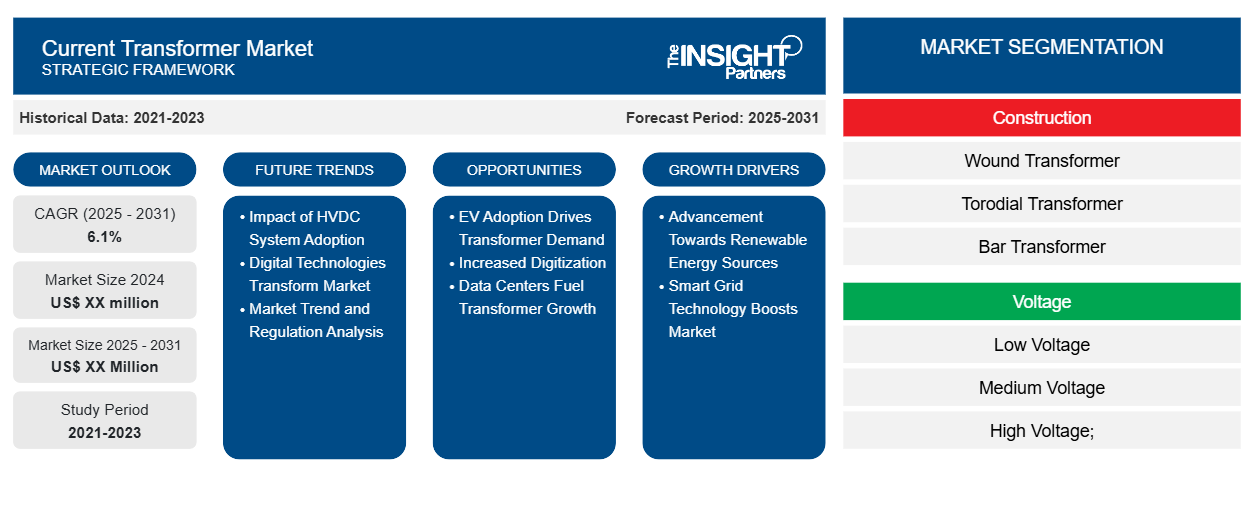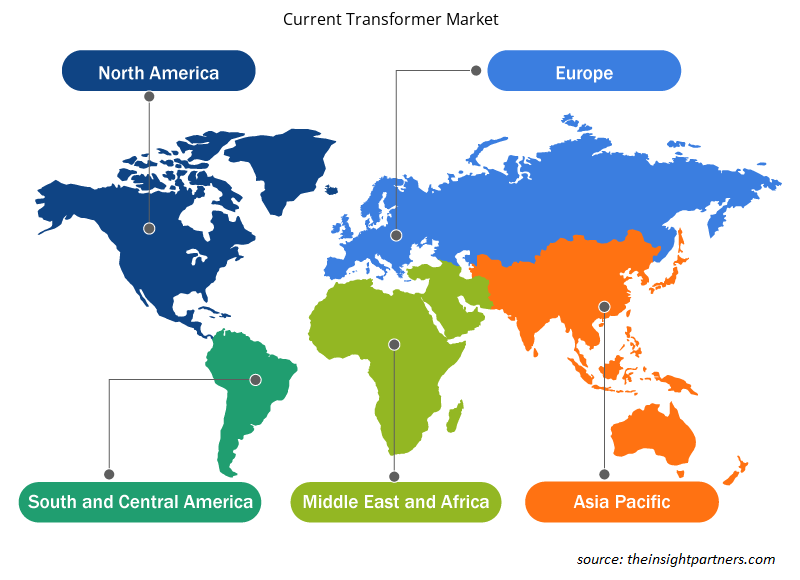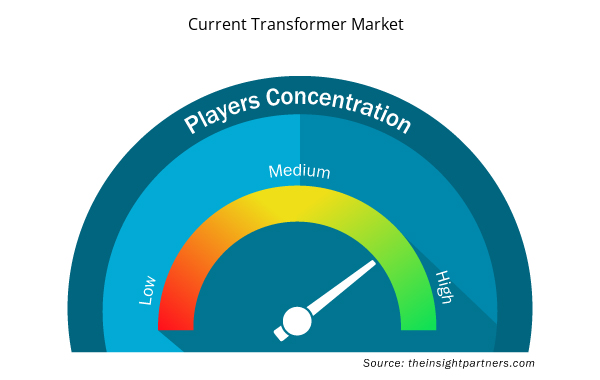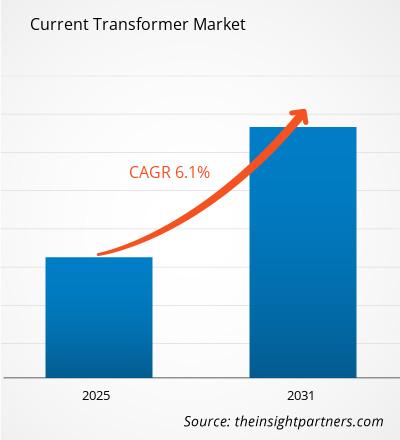Le marché des transformateurs de courant devrait enregistrer un TCAC de 6,1 % de 2025 à 2031, avec une taille de marché passant de XX millions USD en 2024 à XX millions USD d'ici 2031.
Le rapport sur le marché des transformateurs de courant analyse la construction, la tension, l'utilisation et l'application. Géographiquement, le marché est segmenté en Amérique du Nord, Europe, Asie-Pacifique, Amérique du Sud et Amérique centrale.
Objet du rapport
Le rapport sur le marché des transformateurs de courant, publié par The Insight Partners, vise à décrire le paysage actuel et la croissance future, les principaux moteurs, les défis et les opportunités. Il fournira des informations aux différents acteurs du secteur, notamment :
- Fournisseurs/fabricants de technologies : pour comprendre l’évolution de la dynamique du marché et connaître les opportunités de croissance potentielles, leur permettant de prendre des décisions stratégiques éclairées.
- Investisseurs : réaliser une analyse complète des tendances concernant le taux de croissance du marché, les projections financières du marché et les opportunités qui existent tout au long de la chaîne de valeur.
- Organismes de réglementation : Réglementer les politiques et les activités de police sur le marché dans le but de minimiser les abus, de préserver la confiance des investisseurs et de maintenir l’intégrité et la stabilité du marché.
Segmentation du marché des transformateurs de courant
Construction
- Transformateur bobiné
- Transformateur toroïdal
- Transformateur à barres
Tension
- Basse tension
- Moyenne tension
- Haute tension;
Application
- Secteur de l'énergie
- Secteur manufacturier
Géographie
- Amérique du Nord
- Europe
- Asie-Pacifique
- Amérique du Sud et Amérique centrale
- Moyen-Orient et Afrique
Personnalisez ce rapport en fonction de vos besoins
Vous bénéficierez d'une personnalisation gratuite de n'importe quel rapport, y compris des parties de ce rapport, ou d'une analyse au niveau des pays, d'un pack de données Excel, ainsi que de superbes offres et réductions pour les start-ups et les universités.
Marché des transformateurs de courant : perspectives stratégiques

- Obtenez les principales tendances clés du marché de ce rapport.Cet échantillon GRATUIT comprendra une analyse de données, allant des tendances du marché aux estimations et prévisions.
Facteurs de croissance du marché des transformateurs de courant
- Progression vers les énergies renouvelables : Le marché des transformateurs de courant est en plein essor grâce à l'une des tendances majeures : la progression vers les énergies renouvelables. Dans ce contexte, partout où les installations solaires et éoliennes se multiplient dans le monde, des mesures et une surveillance précises des paramètres électriques sont effectuées. L'IRENA a indiqué que la capacité mondiale d'énergie renouvelable était en croissance et atteignait 2 799 GW en 2021. Ce chiffre était déjà de 2 531 GW en 2020. Cette croissance exige des transformateurs de courant performants pour des réseaux stables, ce qui explique la croissance accrue du marché et l'amélioration des parts de marché du secteur de l'énergie.
- La technologie des réseaux intelligents stimule le marché : Le marché des transformateurs de courant est fortement stimulé par la technologie des réseaux intelligents, dont le développement continu le favorise à tel point que les transformateurs de courant pour les réseaux intelligents deviennent très essentiels car ces solutions de mesure offrent une efficacité et une fiabilité améliorées.
Tendances futures du marché des transformateurs de courant
- Impact de l'adoption des systèmes CCHT : L'adoption des systèmes à courant continu haute tension (CCHT) impacte considérablement le marché des transformateurs de courant. Selon les estimations pour 2023, ce marché devrait atteindre 18,8 milliards de dollars d'ici 2026 en raison de la demande de transport d'électricité longue distance efficace. Les incitations gouvernementales en faveur des projets d'énergie renouvelable renforcent cette tendance, comme l'indique l'analyse PEST. La stratégie commerciale des principaux acteurs, notamment ABB et Siemens, serait de se spécialiser strictement dans les transformateurs de courant pour les applications CCHT. Une tendance de plus en plus marquée du marché vers des technologies plus efficaces pour ce type de transport est un signe révélateur.
- Les technologies numériques transforment le marché : les technologies numériques et l'Internet des objets (IoT) révolutionnent le marché des transformateurs de courant. Plus de 50 % des transformateurs de courant pourraient être équipés de systèmes de surveillance numérique et de fonctionnalités IoT d'ici 2025. Analyse SWOT. Les points forts incluent une meilleure collecte et surveillance des données, tandis que les points faibles concernent les risques de cybersécurité.
- Analyse des tendances et de la réglementation du marché : Les courbes s'accentuent et le durcissement des réglementations en matière d'efficacité énergétique et de normes de performance influence le marché actuel des transformateurs. Une analyse PEST démontre que ces réglementations encouragent effectivement l'innovation dans la conception des transformateurs. Les principaux acteurs, tels que General Electric et Eaton, revoient leurs stratégies de marché pour répondre à ces exigences. Cela souligne la dynamique générale du marché qui améliore la performance énergétique et la durabilité. La mise en œuvre de ces normes entraînera une réduction des coûts d'exploitation des services publics pouvant atteindre 10 %.
Opportunités du marché des transformateurs de courant
- L'adoption des véhicules électriques stimule la demande de transformateurs : L'adoption rapide des véhicules électriques nécessite une infrastructure de recharge performante, incluant des transformateurs de courant pour une distribution électrique fluide. On estime que 25 millions de véhicules électriques circuleront sur les routes américaines d'ici 2030. Cela entraînera certainement une forte hausse de la demande de transformateurs de courant fiables. Cette tendance représente une opportunité majeure pour les fabricants spécialisés dans les solutions d'infrastructure pour véhicules électriques. Face à l'évolution des besoins du secteur des transports, ce marché exige davantage d'innovation en termes d'offres produits.
- Numérisation croissante : Avec la transformation numérique constante, le besoin de centres de données ne cesse de croître. Dans ces installations, des systèmes électriques fiables sont indispensables. Par conséquent, des transformateurs de courant sont également nécessaires pour surveiller et contrôler la consommation d'énergie de ces installations. Le marché mondial des centres de données devrait atteindre environ 200 milliards de dollars à l'avenir, principalement en raison de la demande croissante de cloud computing et de stockage de données. Dans ce contexte, les fournisseurs de transformateurs de courant peuvent espérer de belles perspectives de croissance, notamment ceux qui développent des solutions personnalisées pour répondre aux besoins énergétiques spécifiques des centres de données, ce qui renforce leur avantage concurrentiel.
- Les centres de données stimulent la croissance des transformateurs : Face à la hausse des prix de l'énergie et aux enjeux environnementaux, l'efficacité énergétique est devenue une priorité absolue dans de nombreux secteurs. Les transformateurs de courant jouent un rôle crucial dans le suivi de la consommation d'énergie et l'optimisation de la distribution électrique. Par conséquent, compte tenu de l'importance accordée aux solutions de gestion de l'énergie, celles-ci doivent être conformes aux données physiques réelles. Elles sont d'ailleurs fortement recommandées et servent de référence pour la fourniture de solutions de gestion énergétique efficaces. Selon le Département de l'Énergie des États-Unis, l'amélioration de l'efficacité énergétique devrait permettre une réduction globale de la consommation d'électricité de 10 % d'ici 2030. Cette tendance compromet l'immense opportunité offerte aux fabricants actuels de transformateurs de s'organiser et de s'engager dans la recherche et le développement de technologies intelligentes et économes en énergie, parallèlement à l'évolution de la nature du secteur.
Aperçu régional du marché des transformateurs de courant
Les tendances régionales et les facteurs influençant le marché des transformateurs de courant tout au long de la période de prévision ont été analysés en détail par les analystes d'Insight Partners. Cette section aborde également les segments et la géographie du marché des transformateurs de courant en Amérique du Nord, en Europe, en Asie-Pacifique, au Moyen-Orient et en Afrique, ainsi qu'en Amérique du Sud et en Amérique centrale.

- Obtenez les données régionales spécifiques au marché des transformateurs de courant
Portée du rapport sur le marché des transformateurs de courant
| Attribut de rapport | Détails |
|---|---|
| Taille du marché en 2024 | XX millions de dollars américains |
| Taille du marché d'ici 2031 | XX millions de dollars américains |
| TCAC mondial (2025 - 2031) | 6,1% |
| Données historiques | 2021-2023 |
| Période de prévision | 2025-2031 |
| Segments couverts | Par construction
|
| Régions et pays couverts | Amérique du Nord
|
| Leaders du marché et profils d'entreprises clés |
|
Densité des acteurs du marché des transformateurs de courant : comprendre son impact sur la dynamique des entreprises
Le marché des transformateurs de courant connaît une croissance rapide, portée par une demande croissante des utilisateurs finaux, due à des facteurs tels que l'évolution des préférences des consommateurs, les avancées technologiques et une meilleure connaissance des avantages du produit. Face à cette demande croissante, les entreprises élargissent leur offre, innovent pour répondre aux besoins des consommateurs et capitalisent sur les nouvelles tendances, ce qui alimente la croissance du marché.
La densité des acteurs du marché désigne la répartition des entreprises opérant sur un marché ou un secteur particulier. Elle indique le nombre de concurrents (acteurs) présents sur un marché donné par rapport à sa taille ou à sa valeur marchande totale.
Les principales entreprises opérant sur le marché des transformateurs de courant sont :
- Schneider Electric
- GE Grid Electric
- VAC
- SIEMENS AG
- ABB
Avertissement : Les entreprises répertoriées ci-dessus ne sont pas classées dans un ordre particulier.

- Obtenez un aperçu des principaux acteurs du marché des transformateurs de courant
Principaux arguments de vente
- Couverture complète : Le rapport couvre de manière exhaustive l’analyse des produits, des services, des types et des utilisateurs finaux du marché des transformateurs de courant, offrant un paysage holistique.
- Analyse d’experts : Le rapport est compilé sur la base d’une compréhension approfondie des experts et analystes du secteur.
- Informations à jour : Le rapport garantit la pertinence commerciale en raison de sa couverture des informations récentes et des tendances des données.
- Options de personnalisation : ce rapport peut être personnalisé pour répondre aux exigences spécifiques des clients et s'adapter de manière appropriée aux stratégies commerciales.
Le rapport de recherche sur le marché des transformateurs de courant peut donc contribuer à éclairer et à comprendre le contexte et les perspectives de croissance du secteur. Malgré quelques inquiétudes légitimes, les avantages globaux de ce rapport tendent à l'emporter sur ses inconvénients.
- Analyse historique (2 ans), année de base, prévision (7 ans) avec TCAC
- Analyse PEST et SWO
- Taille du marché Valeur / Volume - Mondial, Régional, Pays
- Industrie et paysage concurrentiel
- Ensemble de données Excel



Report Coverage
Revenue forecast, Company Analysis, Industry landscape, Growth factors, and Trends

Segment Covered
This text is related
to segments covered.

Regional Scope
North America, Europe, Asia Pacific, Middle East & Africa, South & Central America

Country Scope
This text is related
to country scope.
Questions fréquemment posées
Some of the customization options available based on request are additional 3-5 company profiles and country-specific analysis of 3-5 countries of your choice. Customizations are to be requested/discussed before making final order confirmation, as our team would review the same and check the feasibility.
The report can be delivered in PDF/PPT format; we can also share excel dataset based on the request.
Key companies in this market are: Schneider Electric, GE Grid Electric, VAC, SIEMENS AG, ABB, Jiangsu Huapeng Transformer, Continental Control System, Trench Limited, Nissin Limited
The Current Transformer Market is expected to register a CAGR of 6.1% from 2023-2031.
Key future trends in this market are - Demand for electrical grid reliability, Integration with smart metering systems, Advancements in transformer efficiency
The major factors impacting the Current Transformer Market are: Increasing Demand for Renewable Energy, Expansion of Smart Grid Infrastructure, and Growing Industrial Automation
Trends and growth analysis reports related to Electronics and Semiconductor : READ MORE..
1.Schneider Electric
2.GE Grid Electric
3.VAC
4.SIEMENS AG
5.ABB
6.Jiangsu Huapeng Transformer
7.Continental Control System
8.Trench Limited
9.Nissin Limited
10.Huayi Electric
The Insight Partners performs research in 4 major stages: Data Collection & Secondary Research, Primary Research, Data Analysis and Data Triangulation & Final Review.
- Data Collection and Secondary Research:
As a market research and consulting firm operating from a decade, we have published and advised several client across the globe. First step for any study will start with an assessment of currently available data and insights from existing reports. Further, historical and current market information is collected from Investor Presentations, Annual Reports, SEC Filings, etc., and other information related to company’s performance and market positioning are gathered from Paid Databases (Factiva, Hoovers, and Reuters) and various other publications available in public domain.
Several associations trade associates, technical forums, institutes, societies and organization are accessed to gain technical as well as market related insights through their publications such as research papers, blogs and press releases related to the studies are referred to get cues about the market. Further, white papers, journals, magazines, and other news articles published in last 3 years are scrutinized and analyzed to understand the current market trends.
- Primary Research:
The primarily interview analysis comprise of data obtained from industry participants interview and answers to survey questions gathered by in-house primary team.
For primary research, interviews are conducted with industry experts/CEOs/Marketing Managers/VPs/Subject Matter Experts from both demand and supply side to get a 360-degree view of the market. The primary team conducts several interviews based on the complexity of the markets to understand the various market trends and dynamics which makes research more credible and precise.
A typical research interview fulfils the following functions:
- Provides first-hand information on the market size, market trends, growth trends, competitive landscape, and outlook
- Validates and strengthens in-house secondary research findings
- Develops the analysis team’s expertise and market understanding
Primary research involves email interactions and telephone interviews for each market, category, segment, and sub-segment across geographies. The participants who typically take part in such a process include, but are not limited to:
- Industry participants: VPs, business development managers, market intelligence managers and national sales managers
- Outside experts: Valuation experts, research analysts and key opinion leaders specializing in the electronics and semiconductor industry.
Below is the breakup of our primary respondents by company, designation, and region:

Once we receive the confirmation from primary research sources or primary respondents, we finalize the base year market estimation and forecast the data as per the macroeconomic and microeconomic factors assessed during data collection.
- Data Analysis:
Once data is validated through both secondary as well as primary respondents, we finalize the market estimations by hypothesis formulation and factor analysis at regional and country level.
- Macro-Economic Factor Analysis:
We analyse macroeconomic indicators such the gross domestic product (GDP), increase in the demand for goods and services across industries, technological advancement, regional economic growth, governmental policies, the influence of COVID-19, PEST analysis, and other aspects. This analysis aids in setting benchmarks for various nations/regions and approximating market splits. Additionally, the general trend of the aforementioned components aid in determining the market's development possibilities.
- Country Level Data:
Various factors that are especially aligned to the country are taken into account to determine the market size for a certain area and country, including the presence of vendors, such as headquarters and offices, the country's GDP, demand patterns, and industry growth. To comprehend the market dynamics for the nation, a number of growth variables, inhibitors, application areas, and current market trends are researched. The aforementioned elements aid in determining the country's overall market's growth potential.
- Company Profile:
The “Table of Contents” is formulated by listing and analyzing more than 25 - 30 companies operating in the market ecosystem across geographies. However, we profile only 10 companies as a standard practice in our syndicate reports. These 10 companies comprise leading, emerging, and regional players. Nonetheless, our analysis is not restricted to the 10 listed companies, we also analyze other companies present in the market to develop a holistic view and understand the prevailing trends. The “Company Profiles” section in the report covers key facts, business description, products & services, financial information, SWOT analysis, and key developments. The financial information presented is extracted from the annual reports and official documents of the publicly listed companies. Upon collecting the information for the sections of respective companies, we verify them via various primary sources and then compile the data in respective company profiles. The company level information helps us in deriving the base number as well as in forecasting the market size.
- Developing Base Number:
Aggregation of sales statistics (2020-2022) and macro-economic factor, and other secondary and primary research insights are utilized to arrive at base number and related market shares for 2022. The data gaps are identified in this step and relevant market data is analyzed, collected from paid primary interviews or databases. On finalizing the base year market size, forecasts are developed on the basis of macro-economic, industry and market growth factors and company level analysis.
- Data Triangulation and Final Review:
The market findings and base year market size calculations are validated from supply as well as demand side. Demand side validations are based on macro-economic factor analysis and benchmarks for respective regions and countries. In case of supply side validations, revenues of major companies are estimated (in case not available) based on industry benchmark, approximate number of employees, product portfolio, and primary interviews revenues are gathered. Further revenue from target product/service segment is assessed to avoid overshooting of market statistics. In case of heavy deviations between supply and demand side values, all thes steps are repeated to achieve synchronization.
We follow an iterative model, wherein we share our research findings with Subject Matter Experts (SME’s) and Key Opinion Leaders (KOLs) until consensus view of the market is not formulated – this model negates any drastic deviation in the opinions of experts. Only validated and universally acceptable research findings are quoted in our reports.
We have important check points that we use to validate our research findings – which we call – data triangulation, where we validate the information, we generate from secondary sources with primary interviews and then we re-validate with our internal data bases and Subject matter experts. This comprehensive model enables us to deliver high quality, reliable data in shortest possible time.

 Obtenez un échantillon gratuit pour ce rapport
Obtenez un échantillon gratuit pour ce rapport